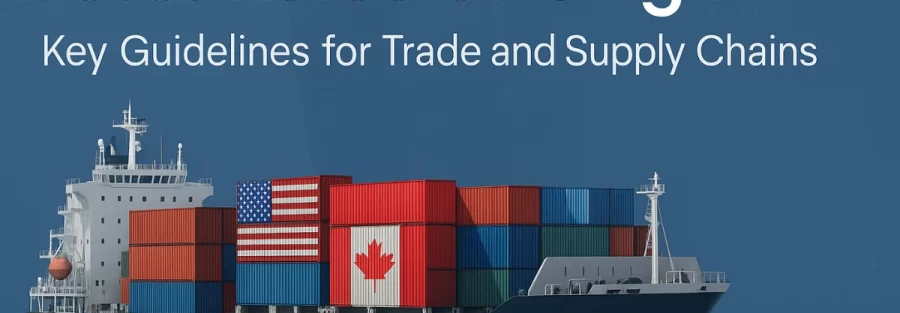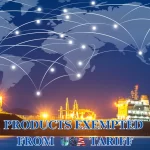In today’s world of country-specific tariffs, the U.S. origin rules have become critical for global trade. Indian businesses exporting to the U.S. must carefully track where their goods are made, because each product’s declared origin now determines the duties it pays. U.S. law defines origin by tests like “wholly obtained” or “substantial transformation”. In practice, every component and processing step in India must be documented to claim a product as Indian origin. Failure to meet these tests means U.S. Customs may treat the goods as coming from a higher-tariff country instead.
Country-of-Origin Tariffs Are Rising
The U.S. has moved from uniform tariffs to heavy, country-specific levies. A recent 2025 trade order imposed a 10% base tariff on all imports, rising to 11–50% depending on the exporter. India’s imports face roughly mid-20% rates under this scheme, far above the ~10% duty most countries had paid before. By contrast, Chinese-made goods are hit with duties as high as 245%. In this climate, origin is everything. For example, an Indian-made product that includes expensive Chinese parts — without sufficient reworking in India — will be classified as Chinese and incur the punitive tariff. In short, whether a shipment is tagged “Made in India” or “Made in China” can mean the difference between 10% duties and 245% duties. Indian exporters must therefore understand and apply U.S. origin rules to minimize their tariff burden.
Rules of Origin: Key Criteria
U.S. origin rules fall into two categories: non-preferential (no trade agreement claim) and preferential (FTA or GSP claim). For most Indian exports (no U.S.-India FTA yet), the non-preferential test applies. Here, a good is Indian-origin if it is “wholly obtained” in India (e.g. minerals or crops grown there) or if it is “substantially transformed” in India. Substantial transformation means the product’s form or character changed enough in India – typically through significant processing or value-add – to become a new article. Simple operations (like repacking, relabeling, or minor assembly) generally do not count as transformation. For example, cutting cloth in India into apparel may be sufficient, whereas merely stitching imported fabric might not.
Preferential origin (for things like a future U.S.-India FTA or GSP) often adds stricter rules. These rules usually require a minimum percentage of local content or a change in tariff classification. To claim a tariff preference, exporters must provide a government-issued Certificate of Origin (CO) in India, certified by an authorized agency. (U.S. law only obligates receipt of a CO when seeking lower FTA/GSP rates.) Without such a certificate, shipments simply enter at the regular Most-Favored-Nation rates for India. In practice, this means Indian companies aiming for any U.S. trade benefits must start gathering proof — invoices, supplier declarations, production records — to back up any origin claim.
Impact on Indian Businesses
- Lost GSP Benefits: India’s removal from the U.S. Generalized System of Preferences (GSP) in 2019 illustrates the stakes. Prior to that, roughly $5.6 billion of Indian exports entered the U.S. duty-free under GSP. When India lost GSP, those goods simply faced normal MFN duties. (Many of the affected products — like certain textiles and chemicals — now carry higher tariffs.) Any future revival of GSP or an FTA will depend on meeting origin rules.
- Avoiding Misrouting: Indian exporters are urged to avoid treating India as a transit point for mainly Chinese products. The Global Trade Research Initiative warns that simply shipping Chinese-made items through India without meaningful India-based processing risks being classified as Chinese origin. In fact, India’s own Trade Remedies agency (DGTR) is watching for such transshipment schemes. Indian firms should instead focus on genuine value-add in India, using Indian or other allowable inputs, to qualify as Indian-made. Failing to do so could backfire: U.S. Customs is now asking for detailed data on foreign inputs, and may demand proof of origin rather than accepting a simple origin declaration.
- Risk of Penalties: U.S. enforcement is tough. CBP’s Penalties Program makes clear that mislabeling origin is illegal and punishable. Under trade agreements, an exporter or producer who falsely certifies origin can be penalized, and importers face penalties for false claims on customs documents. Maintaining audit-ready records (e.g. bills of materials, production logs) is now essential.
- Opportunities if Well-prepared: On the positive side, mastering origin rules can lead to tariff savings. In trade negotiations, Indian exporters (especially apparel and engineering sectors) have advocated for relaxed origin criteria in a future India-US pact. For instance, they want rules allowing them to “add value with ease” to goods partly made in China and still claim Indian origin. Even now, if exporters restructure supply chains to source more inputs from India (or from U.S. FTA partners), they could better position their products for any new preferential access. Planning strategic sourcing – say, using more Indian components or inputs from NAFTA partners – might become a competitive edge if a U.S.-India agreement materializes.
- Strategic Sourcing: Considering origin-sensitive tariffs, Indian firms should audit their supply chains. Questions to ask: Are high-tariff inputs (like Chinese electronics) necessary, or can alternatives be found? Could more of the production be shifted to India so the “Indian content” % goes up? Sometimes sourcing from the U.S. or an FTA country might avoid extra duties. By contrast, minor processing of high-foreign-content goods is likely to invite heavy U.S. duties.
Best Practices for Indian Traders
- Document Everything: Maintain detailed records of suppliers, bills of materials, and production steps. U.S. authorities may ask for invoices showing where each part was made. If you claim origin benefits, ensure a proper Certificate of Origin (or equivalent proof) backs each shipment.
- Add Real Value: Don’t rely on minimal assembly. To make goods “Made in India,” process them enough to change their tariff classification or character. For example, weaving imported yarn into cloth or manufacturing complex machinery parts in India strengthens an Indian-origin claim. As GTRI advises, focus on genuine value-add rather than merely routing Chinese-made goods through India.
- Know the rules of any preference: If exporting under a U.S. preferential program (hypothetical FTA or GSP), study its origin criteria. Many agreements allow a limited “de minimis” of foreign content or include cumulation with partner countries. But right now, the only way to get U.S. tariff relief is if India negotiates it. Stay tuned to policy talks – business leaders are already urging relaxed origin rules in those discussions – and be ready to adapt if a deal is struck.
- Avoid Risky Shortcuts: Never engage in prohibited transshipment. Misrepresenting origin (e.g. labeling goods as “Made in India” when inputs are foreign) is fraud. Regulators globally (including India’s customs) are tightening scrutiny to prevent such abuse.
- Stay Compliant: US penalties for origin fraud can include hefty fines, seizure of goods, and even jail time under the False Claims Act. Regularly train staff on origin rules and update internal audits. Consult customs experts to verify that your classification and origin statements meet U.S. requirements.
By proactively managing country-of-origin issues, Indian exporters and importers can avoid punitive U.S. tariffs and even capitalize on any preferential access. In the evolving trade environment, a transparent supply chain and rigorous documentation are key. As one expert notes, companies should “be ready to furnish adequate documents to prove the origin of the goods”. With careful planning and compliance, Indian businesses can navigate U.S. rules of origin and turn them from a risk into an opportunity.



